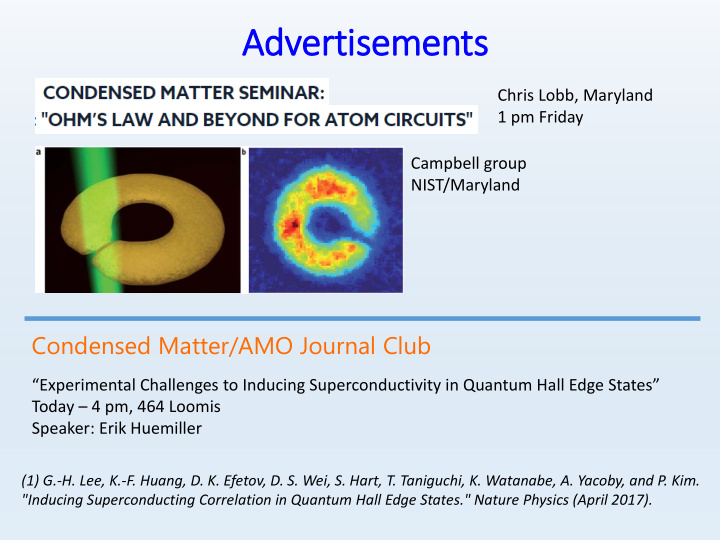



Adver ertisem emen ents Chris Lobb, Maryland 1 pm Friday Campbell group NIST/Maryland Condensed Matter/AMO Journal Club “Experimental Challenges to Inducing Superconductivity in Quantum Hall Edge States” Today – 4 pm, 464 Loomis Speaker: Erik Huemiller (1) G.-H. Lee, K.-F. Huang, D. K. Efetov, D. S. Wei, S. Hart, T. Taniguchi, K. Watanabe, A. Yacoby, and P. Kim. "Inducing Superconducting Correlation in Quantum Hall Edge States." Nature Physics (April 2017).
Finishing up from last time… Three ee-leve vel s systems – “Lam ambda” a” s system em e ( ) − ω − ϕ Ω i t e 2 2 ( ) − ω − ϕ Ω 2 i t e 1 1 1 2 1
Finishing up from last time… Three ee-leve vel s systems – “Lam ambda” a” s system em e ( ) − ω − ϕ Ω i t e 2 2 ( ) − ω − ϕ Ω 2 i t e 1 1 1 2 1 Populations Time [arb.]
Finishing up from last time… STImulated ed Ra Raman an A Adiab abatic Passage Populations Time [arb.] Time [arb.] Ω 1 , 2
Ope pen n quan quantum s systems: Dissipation on i in atom omic c physics cs / / ultracol old at atoms 2 ~ ω 12 1
Ope pen n quan quantum s systems: Dissipation on i in atom omic c physics cs / / ultracol old at atoms We work with fairly well-isolated systems, held in ultrahigh vacuum, but on some timescale it’s going to interact with the “environment.” If we’re not monitoring the environment [hard to do], then we’ll lose information about our system. ATRAP experiment How do we treat this? What role does dissipation play in AMO systems?
Lase La ser-cooling of g of a atom oms 2 Photon momentum imparted when ~ ω the atom is first excited. The decay 12 let’s us “cycle” this process over and over ALSO – we start with high-entropy ensemble, the degrees of freedom of the light field help 1 accommodate the removal of entropy
Lase La ser-cooling of g of a atom oms 2 T ~ 300-400 K ~ ω 12 many cycles T ~ few millionths of 1 K MOT 1997 Nobel Prize in Physics 1 & optical molasses Chu, Phillips, Cohen-Tannoudji
Optical p pumping e.g., ., take e a ther ermal en ensemble a and p prep epare a s spin-pol olarized s samp mple Let’s say we want to prepare in the state |1/2 , 1/2> Polarized light + sponteneous decay
Optical p pumping e.g., ., take e a ther ermal en ensemble a and p prep epare a s spin-pol olarized s samp mple if a a b if b 1966 Nobel Prize in Physics Alfred Kastler “Optical Methods for Studying Hertzian Resonances”
Dark st states States de decoupl upled ed f from rest o of dy dyna namics – no no excited s ed state compo ponen ent Our 3-level system, with loss population gets “trapped” in dark state at long times Dark state Bright state from Zoller…
Veloci ocity-select ctive c coh oherent p pop opulation on t trapping sub-rec ecoi oil c cool ooling!!! g!!! also… gray molasses, related techniques… from Zoller… developed by Cohen-Tannoudji/Chu/etc.
OK, K, i impor ortant t to l o laser-cool ooling. Wha hat el else? e? Can we modify how our system interacts with the environment to influence processes like spontaneous emission? Purcell enhancement (1940 ; 1952 Nobel) Γ Enhance : bring some “emitter” near 2 a structure / waveguide matching its frequency Γ ~ ω Effectively 12 Γ suppress : put the emitter into a “cavity” with frequency matched to resonance. If photon lifetime in cavity is long enough, reabsorption more likely than loss 1
OK, K, i impor ortant t to l o laser-cool ooling. Wha hat el else? e? Can we modify how our system interacts with the environment to influence processes like spontaneous emission? Purcell enhancement (1940 ; 1952 Nobel) Γ Enhance : bring some “emitter” near 2 a structure / waveguide matching its frequency Γ ~ ω Effectively 12 Γ suppress : put the emitter into a “cavity” with frequency matched to resonance. If photon lifetime in cavity is long enough, reabsorption more likely than loss 1
Dis issip ipatio ion as a as a reso source f for man any-body ph physi sics General theme in many-body physics – going to low energies leads to emergent behavior i.e., due to energetic restriction of accessible Hilbert space
Dis issip ipatio ion as a as a reso source f for man any-body ph physi sics General theme in many-body physics – going to low energies leads to emergent behavior i.e., due to energetic restriction of accessible Hilbert space Total Hilbert space Low-energy region
Dis issip ipatio ion as a as a reso source f for man any-body ph physi sics If we start in some part of Hilbert space, can we restrict ourselves to this region using dissipation? answer, of course Basically, just the Total Hilbert space quantum Zeno effect Γ ex: stabilization of ultracold molecules against exothermic chemical reactions Low-energy region Γ
Dis issip ipatio ion-constrained d dynamics cs How about for cold atoms? Loss due to 3-body molecular recombination Stabilization of the p-Wave Superfluid State in an Optical Lattice Y.-J. Han, Y.-H. Chan, W. Yi, A. J. Daley, S. Diehl, P. Zoller, and L.-M. Duan Phys. Rev. Lett. 103, 070404 – Published 14 August 2009
Dis issip ipatio ion-constrained d dynamics cs
“Dark states” i in many-body s systems Making stable Majoranas through “dark state” engineering many, m many more e examples… es… analog ogs of QED QED new c w cool ooling techniques es etc. Topology by dissipation in atomic quantum wires Sebastian Diehl, Enrique Rico, Mikhail A. Baranov, & Peter Zoller Nature Physics 2011
Recommend
More recommend